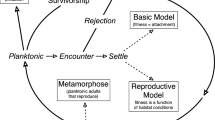Abstract
High intertidal rocky shores are extremely stressful habitats. Marine snails in these habitats experience highly desiccating conditions, and they locate refuges such as crevices and form dense aggregations of individuals to reduce the effects of desiccation. This study investigates the mechanisms of refuge location in Melarhaphe neritoides using a simple set of rules to mimic the behaviour of each individual snail as a computer simulation. Chance interactions with other individuals, other individuals’ trails and the crevices which form part of the virtual environment result in a mainly self-organised pattern of aggregations and crevice occupation which match real patterns obtained in laboratory experiments. Simulations where the following of trails is removed result in a poorer match to the experimental data, indicating the importance of trail-following in establishing these distribution patterns. The study shows that artificial life based models are a potentially useful tool in the investigation of rocky shore systems.
Preview
Unable to display preview. Download preview PDF.
Similar content being viewed by others
References
Chowhury, D., Nishinari, K., Schadschneider, A.: Self-organized patterns and traffic flow in colonies of organisms: From bacteria and social insects to vertebrates. Phase Transit 77, 601–624 (2004)
Helbing, D., Molnar, P.: Social force model for pedestrian dynamics. Phys. Rev. E 51, 4282–4286 (1995)
Nagatani, T.: The physics of traffic jams. Rep. Prog. Phys. 65, 1331–1386 (2001)
Krause, J., Ruxton, G.D.: Living in Groups. Oxford University Press, Oxford (2002)
Sword, G.A., Lorch, P.D., Gwynne, D.T.: Migratory bands give crickets protection. Nature 433, 703 (2005)
Dunbar, R.I.M.: Determinants of group size in primates: A general model. Proc. Brit. Acad. 88, 33–57 (1996)
Parrish, J.K., Edelstein-Keshet, L.: Complexity, pattern, and evolutionary trade-offs in animal aggregation. Science 284, 99–101 (1999)
McFarland, D.: Animal Behaviour, 3rd edn. Longman, Harlow (1999)
McMahon, R.F.: Thermal tolerance, evaporative water loss, air water oxygen consumption and zonation of intertidal prosobranchs: a new synthesis. Hydrobiologia 193, 241–260 (1990)
Stafford, R., Davies, M.S.: Temperature and desiccation do not affect aggregation behaviour in high shore littorinids in north-east England. Journal of Negative Results: Ecology and Evolutionary Biology 1, 16–20 (2004)
Fretter, B., Graham, A.: British prosobranch molluscs. Ray Society, London (1994)
Stafford, R., Davies, M.S.: Spatial patchiness of epilithic biofilm caused by refuge-inhabiting high shore gastropods. Hydrobiologia (in press)
Garrity, S.D.: Some adaptations of gastropods to physical stress on a tropical rocky shore. Ecology 65, 559–574 (1984)
Chapman, M.G., Underwood, A.J.: Influences of tidal conditions, temperature and desiccation on patterns of aggregation of the high-shore periwinkle Littorina unifasciata in New South Wales, Australia. J. Exp. Biol. Ecol. 196, 213–237 (1996)
Stafford, R.: The role of environmental stress and physical and biological interactions on the ecology of high shore littorinids in a temperate and a tropical region. Ph.D. thesis, University of Sunderland, Sunderland (2002)
Raffaelli, D.G., Hughes, R.N.: The effects of crevice size and availability on populations of Littorina rudis and Littorina neritoides. J. Anim. Ecol. 47, 71–83 (1978)
Britton, J.C., McMahon, R.F., Hart, J.W.: Relationships between topography, substratum composition and surface temperature, and the spatial distribution of intertidal fauna on rocky shores of south-western Australia. In: Wells, F.E., Walker, D.I., Kirkman, H., Letherbridge, R. (eds.) The Marine Flora and Fauna of Albany, Western Australia, Western Australian Museum, Australia, pp. 521–540
Chapman, M.G.: Variability in trail-following and aggregation in Nodilittorina unifasciata Gray. J. Exp. Biol. Ecol. 224, 48–71 (1998)
Erlandsson, J., Kostylev, V.: Trail following, speed and fractal dimension of movement in a marine prosobranch, Littorina littorea during a mating and a non-mating season. Mar. Biol. 122, 87–94 (1995)
Underwood, A.J.: Experiments in ecology. Cambridge University Press, Cambridge (1997)
Focardi, S., Deneubourg, J.L., Chelazzi, G.: How shore morthology and orientation mechanisms can affect the spatial-organisation of intertidal molluscs. J. Theor. Biol. 112, 771–782 (1985)
Burrows, M.T., Hawkins, S.J.: Modelling patch dynamics on rocky shores using deterministic cellular automata. Ecol. Prog. Ser. 167, 1–13 (1998)
Rushton, S.P., Lurz, P.W., South, A.B., Mitchell-Jones, A.: Modelling the distribution of red squirrels (Sciurus vulgaris) on the Isle of Wight. Anim. Conserv. 2, 111–120 (1999)
Taylor, C.E., Jefferson, D.: Artificial life as a tool for biological inquiry. Artificial Life 1, 1–13 (1994)
Davies, M.S., Hawkins, S.J.: Mucus from marine molluscs. Adv. Mar. Bio. 34, 1–71 (1998)
Author information
Authors and Affiliations
Editor information
Editors and Affiliations
Rights and permissions
Copyright information
© 2005 Springer-Verlag Berlin Heidelberg
About this paper
Cite this paper
Stafford, R., Davies, M.S. (2005). Examining Refuge Location Mechanisms in Intertidal Snails Using Artificial Life Simulation Techniques. In: Capcarrère, M.S., Freitas, A.A., Bentley, P.J., Johnson, C.G., Timmis, J. (eds) Advances in Artificial Life. ECAL 2005. Lecture Notes in Computer Science(), vol 3630. Springer, Berlin, Heidelberg. https://doi.org/10.1007/11553090_53
Download citation
DOI: https://doi.org/10.1007/11553090_53
Publisher Name: Springer, Berlin, Heidelberg
Print ISBN: 978-3-540-28848-0
Online ISBN: 978-3-540-31816-3
eBook Packages: Computer ScienceComputer Science (R0)




